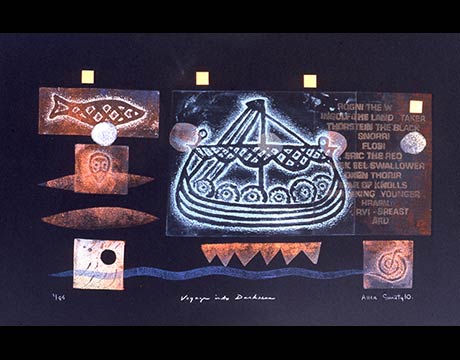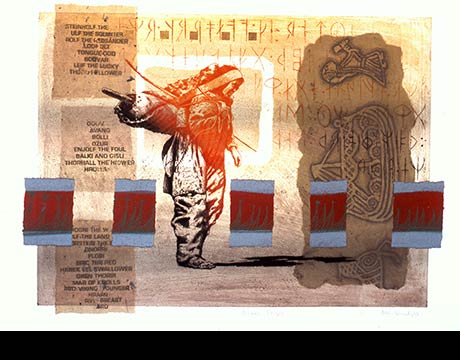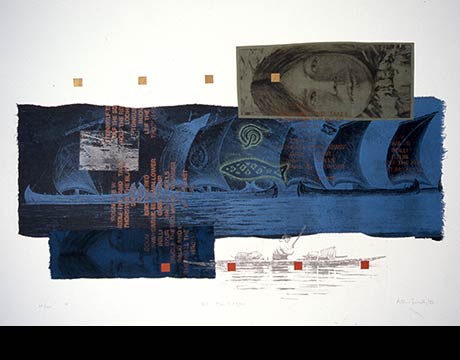Gallery - Past Exhibitions - 1997 - First Millennium: Greenland
(Click image for slideshow)
Cathedrals from a dark age
float here
When sinew and stretched skinned
the hunted stalked their brethren
And the shadow of dragon ships
entered the void.
First Encounter: etchingIn the summer of 1997, I travelled to South Greenland to kayak from the ocean's coast, through some massive fiords to the foot of the great Greenland ice cap. The primal elements in the south were similar to the other regions of Greenland I have seen; towering mountains of lacerated rock, huge glaciers and icebergs, and crystal clear water. Yet the feeling in the south was different - the memories left on that land came from other origins.
A thousand years ago two races of people previously unknown to one another crossed paths in the ice bound solitude of Greenland.
Dragon Boats: etching From the east, the Vikings. Originating in Scandinavia, their meteoric surge saw them penetrate into Russia, over run Europe, forage the Byzantine Empire, colonialize Iceland and Greenland, and expand the boundaries of the known world in North America. Fiercely individualistic, with an unending appetite for conquest, their reckless courage and ferocity historically define them.
The Thule people (to-day's Inuit) came from the west, continuing their slow progression from Alaska, gradually replacing the Dorsets as the Arctic's dominate people. These were semi-nomadic hunters, self-reliant, extremely tough, and ingeniously adapted to their world.
From stature and complexion, to culture, beliefs and disposition, the Thules and Vikings were from 'other worlds'. Yet what enable them to both be in Greenland a thousand years ago was the one thing they had in common - boats.
Voyage into Darkness: etching Both the Thule kayak and the Norse sailing ships were unrivalled at that time, in design and function. To-day both vessels are considered landmarks in the history of maritime travel.
The fiords where I was paddling were dotted with Viking ruins. Across the fiord from our destination at Narsarsuaq, sits Erik the Red's farm at Brattahlid. It was from there that Erik's son Leif the Lucky set out 1000 years ago and discovered North America, five hundred years before Columbus.
Amazingly, at the same time and place that we finished our expedition an exact replica Viking ship was being readied to depart to North America to commemorate Leif's voyage. A further surprise was that the American who dreamed up the idea and who commissioned the ship to be built, hired a friend of mine Terry Moore, to captain it. With 12 men, 8 oars, 1 mast, an open deck, a side rudder and nine tons of Greenland boulders as ballast, it was a medieval time machine that couldn't help but take your breath away. Its sumptuous form crystallized the Norse duality: refinement and intimidation. The boat brought alive the ruins I had previously seen and the Viking history I had read.
First Millennium: monoprint The Thules didn't widely populate the southern tip of Greenland, however they did travel there to hunt. The Vikings also would have encountered them around their west coast settlements and while exploring the Thule's prime sea hunting grounds further north.
For the Thules, seeing the Vikings and their ships for the first time must have been like witnessing aliens arriving on space ships from another planet. One can hardly image their reaction to everyday Norse items such as fabric, lumber, domestic animals, farm produce, metal utensils and weapons.
In historic accounts, the Vikings refer to the Thule (and all other North American native people) as skaelings. The Norse believed they possessed a strange dark force, able to appear and disappear like fantoms out of the land. Like almost all European explorers that followed, the Viking greatly under estimated indigenous people.
The evidence of Thule-Viking interaction is scant. Old Norse sagas, some oral history, and some ruins and artifacts sprinkled across the north are what remain.
:: BACK TO GALLERY






